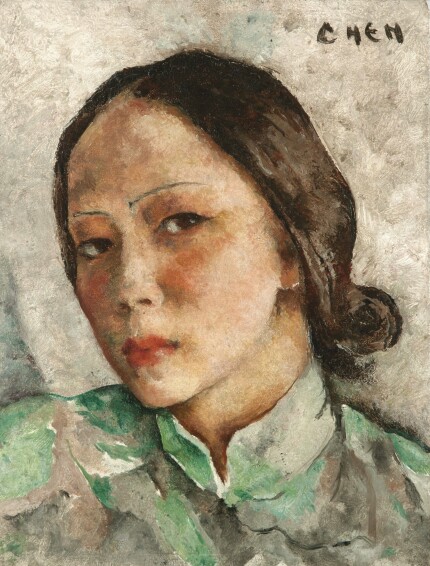- 1028
Georgette Chen
Description
- Georgette Chen
- Self-Portrait
- Signed
- Oil on wood
- 35 by 27 cm.; 13 3/4 by 10 1/2 in.
Provenance
Private Asian Collection
Condition
"In response to your inquiry, we are pleased to provide you with a general report of the condition of the property described above. Since we are not professional conservators or restorers, we urge you to consult with a restorer or conservator of your choice who will be better able to provide a detailed, professional report. Prospective buyers should inspect each lot to satisfy themselves as to condition and must understand that any statement made by Sotheby's is merely a subjective, qualified opinion. Prospective buyers should also refer to any Important Notices regarding this sale, which are printed in the Sale Catalogue.
NOTWITHSTANDING THIS REPORT OR ANY DISCUSSIONS CONCERNING A LOT, ALL LOTS ARE OFFERED AND SOLD AS IS" IN ACCORDANCE WITH THE CONDITIONS OF BUSINESS PRINTED IN THE SALE CATALOGUE."
Catalogue Note
Georgette Chen was born to an affluent Chinese antique dealer and republican revolutionary, who owned businesses in Paris, London and New York. Constantly being uprooted due to her father’s Western business ventures and frequently visiting China with her family, Chen lived an itinerant and international life. At once a Chinese girl from a nationalistic family, a bohemian artist in Paris, and the wife of an eccentric and spirited statesman, Georgette possessed a diverse disposition on a social, cultural, and emotional level. Veritably, this uncommon and introspective self-portrait embodies the artist’s multifaceted identity.
Though her parents exposed their prodigy to Chinese brushwork as a child, they had her privately trained in oil painting by a Russian émigré and she forthwith found an affinity towards Western art. She spent hours wandering through the numerous Parisian museum halls as a young girl and decided to build her aesthetic foundation at the Art Students League in New York (1926-7). It was only later, however, when she developed her distinctive painting style at the Academie Colarossi and Academie Biloul (1927-30) in Paris. Marriage to diplomat Eugene Chen, the foreign minister of the Republic of China, perpetuated her life of travel and she constantly mingled within the artistic haut monde. After a brief stint in Penang, Malaysia, Chen eventually settled in Singapore in 1954, remaining there until the end of her life in 1993.
Similar to Cezanne’s self-portrait which is deliberately composed to leave little room for the negative space in the backdrop, the artist’s countenance dominates the picture plane. The hyperbolic scale of the face renders the image intriguing and intense; the experience of viewing the work mimics that of intently looking in a mirror or drawing very intimate contact with another individual. The prim Chinese collar concealing her neck and her neatly pinned, elegantly arranged hair place further focus on her memorable visage, adding to her mystique.
By applying soft shadows and subtle highlights that reveal the contours of her delicate facial features, she permeates the image with an impression of reticent calmness. She was loyal to the French salon style of painting throughout her career, while her subject matter often varied based on her environs. Chen utilizes a muted palette and applies the paint to the canvas in the technical manner of a post-impressionist painter. Influenced by the formal elements of the late 19th century, fin-de-siecle movements, her brushstrokes are vigorous, unrestricted and loosely fragmented, akin to those of Corot and Cezanne.
Given the youthful glow resonating from Chen’s appearance, this work was conceivably executed in the early 1930s, while the artist was residing in France and experimenting with portraiture. Bearing a reserved expression on her slightly tilted face, Chen is imbued with a sense of feminine vulnerability. Yet, her intense eyes tellingly penetrate the viewer’s consciousness in an arresting and artful symphony. She is mindful of one’s presence, but remains deliberately aloof and silent. The observer is urged to empathize with her timidity, but simultaneously feels confronted by her knowing scrutiny. Painted by a woman prevalent within the context of the male-dominated art circles of 20th century Asia, the self-portrait skillfully captures the contradictory elements of Chen’s character: she is sensitive yet detached, sincere yet private, shy yet determined.
This work is to be featured in The Worlds Of Georgette Chen, an upcoming docudrama produced by Channel NewsAsia and commissioned by the National Gallery Singapore, which will air by April 2015. The owner of this painting, once the artist’s dear neighbor in Singapore, nostalgically recalls his afternoons as a mischievous toddler who played in Chen’s garden and guarded her compound while she taught at the Nanyang Academy of Fine Arts. He would pose for her paintings, gather rambutans for her still life works, and listen to anecdotes about her ambulant life as she served him tea and cakes. Decades later, he visited Georgette as an older woman and asked to take a picture with her for remembrance. In lieu of a photograph, the frail artist gifted him this cherished self-portrait as a vestige of her younger years and her former vitality. We at Sotheby’s feel honored to have the rare opportunity of exhibiting a Southeast Asian painting of this art historical caliber in Singapore, Jakarta, Taiwan and Hong Kong, and to offer the first self-portrait by Georgette to ever appear in the public market.

